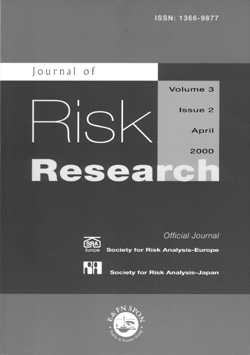ENVIRONMENTAL HAZARDS: ASSESSING RISK AND REDUCING DISASTERS. Keith Smith, Routledge Physical Environment Series, 2001. ISBN 0-415-22464-0 (third edition, paperback, 18 plates, 95 figures, 44 tables). vi+391 pages. Price UK. £19.00
Simultaneously published in Canada and the USA.
Environmental Hazards is a remarkable guide to disaster risk reduction for development planners, environmental activists, economists, sociologists, urban planners, city government officials, NGO staff and others involved in all disaster reduction phases. The first edition of Environmental
Hazards was published at the start of the IDNDR; the publication of this third edition at the turn of the new century provides an opportunity to
reflect on progress made during the IDNDR and challenges in the twenty-first century.
The book has two parts: the first addresses "The Nature of Hazard", and the second "The Experience and Reduction of Hazard". Part I provides a theoretical framework for risk reduction. It argues that the built environment is expanding fast
because of growing population, technological
advances and the resulting expansion in economic activities. The expansion of built environments often transgresses the threshold of safe space and extends into fragile zones. In this way, greater numbers of people and property are put at risk from the forces of nature. Over the past few
decades, the occurrence of
disastrous events has increased in real terms, and this tendency could continue in the next
century if current trends in demographic, social and economic spheres remain constant.
Part II describes experiences of risk
reduction in tectonic, mass movement, severe storm, biological and biophysical, hydrological and technological hazards. Each chapter discusses the nature and examples of the given hazard, its trends and patterns. This is followed by a detailed account of loss-sharing and hazard and vulnerability
reduction strategies. It highlights that different types of hazards have differential impacts on different countries, and that the issues and problems faced are also dissimilar.
The book recommends integration of learning from natural and social sciences in order to
formulate effective risk reduction strategies. It is imperative that a combination of scientific and
social research methods is applied for risk assessment and hazard reduction. Vulnerability must be understood in physical, socio-economic and political terms and should be addressed through community empowerment, strengthening
indigenous coping mechanisms and by providing better economic alternatives to disaster-prone communities. In short, the book proclaims cross-disciplinary and multi-sectoral approaches as the emerging answers to effective disaster risk reduction in the twenty-first century.
Although the book emphasizes community
participation for effective risk reduction, practitioners are reminded not to exaggerate the lay
perspective of risk beyond the results of objective analysis when making decisions. This could be erroneous and may lead to wasteful spending of money to achieve only a negligible improvement in safety.
Environmental Hazards suggests three ways of addressing risks: one, modify the loss burden; two, modify the
hazard event, and three, modify the human vulnerability. Loss burden could be modified or shared after a disaster by providing aid and compensation through insurance schemes. Event modification takes place either by controlling environmental processes in
order to stop hazard occurrence or through diversion of the hazard after its occurrence, e.g., diverting flood-waters by building dams or alternative channels. Human
vulnerability could be modified by focusing on community preparedness, better forecasting and warning, and land-use planning.
On the whole, the book provides wide-ranging insights on effective risk reduction for practitioners and policy-makers alike. It is comprehensive while describing technical details related to broadly diverse and complex topics. However, it would have been better to draw on more examples from other contexts rather than the current slightly dominant focus on the USA.
 | |
Journal of Risk Research, published by E & FN Spon, Taylor & Francis Ltd. London, U.K., ISSN 1366-9877, US$310. This Journal can be ordered from Routledge Journals, Taylor & Francis Ltd. Customer Services Department, Rankine Road, Basingstoke, Hampshire RG24 8PR, UK. Tel: +44 (0) 1256 813000, Fax: +44(0) 1256 330245 or www.tandf.co.uk
The Journal of Risk Research is the official journal of the Society for Risk Analysis Europe and Society for Risk Analysis Japan. This quarterly journal publishes peer reviewed theoretical and empirical research articles within the risk field from the areas of engineering, physical, health and social sciences, as well as articles related to decision making, regulation and policy issues in all disciplines.
|
Zubair Murshed is a Training Manager in the Training and Education Department at ADPC, Bangkok, Thailand
|



![]() To get announcements whenever this page is updated, please subscribe to adpc-announce-subscribe@egroups.com
by sending a blank email.
To get announcements whenever this page is updated, please subscribe to adpc-announce-subscribe@egroups.com
by sending a blank email.